Size matters
04 January 2017
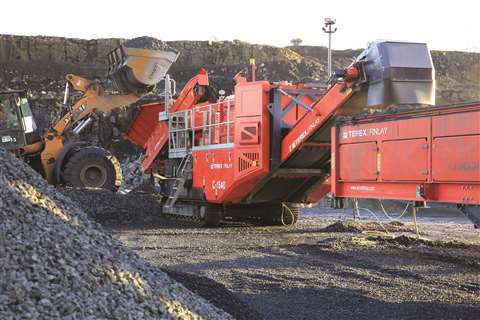
Terex Finlay’s C-1540 crusher – launched last year – features a fuel efficient direct drive transmission via a clutch
Moving on from debates over mobility and reliability, issues that matter to buyers of crushing and screening equipment now include simplicity of use.
This includes not only the speed of setting up and tearing down, but also an uncomplicated approach to the on-board technology.
New machines need to be working at optimum levels for as long as possible – and repairs and maintenance need to be minimal and easily undertaken. Operators need to have a solid understanding of how machines are performing and when and how adjustments need to made.
And, of course, buyers need to have a clear idea of the machine that is best equipped to do the job required.
Mobile workhorses
In 2016, Terex Finlay launched a new cone crusher to its range – the C-1540 – as well as a new screener, the 674.
Terex says the fuel efficient direct drive crusher is designed for use by medium sized producers and contract crushing operators.
The C-1540 features the Terex 1000 cone, which is choke fed with integrated level sensor automated tramp relief and hydraulic closed side setting (CSS) adjustment. The hopper/feeder has automated metal detection and a purge system to protect the cone and reduce the downtime caused by contaminants.
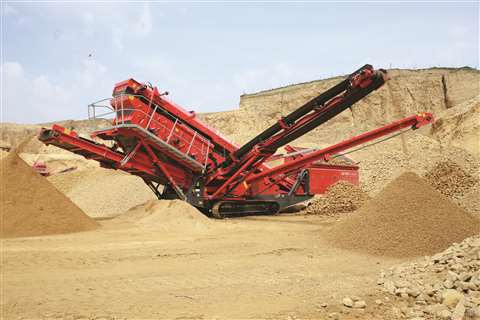
The largest conveyor on Terex Finlay’s 674 has variable tilt and side slew to accurately discharge material for recirculation and stockpiling
Rapid set-up time and easy maintenance, as well as an advanced electronic control system are additional benefits.
Terex Finlay’s new 674 screening machine features a three-deck screenbox, giving a screening area of almost 15.8m2. With quick wedge tensioning, access holes and bottom deck hydraulic tensioning system, the time required to make mesh changes is reduced; this along with a compact design, making the 674 easy to transport, set up and take down, are some of the screen’s benefits.
Jaw crushers
Belgian firm Keestrack has four models within its ‘B’ Series – from the 30-tonne-allrounder B3 to the 60-tonne B6, which is capable of producing around 350 tonnes per hour (tph).
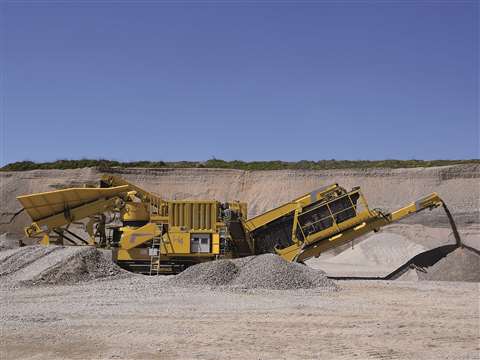
The new cone crusher Keestrack H4 with hybrid drive technology and triple deck afterscreen is setting new standards in economy and production diversity within the 50-tonnes class.
All Keestrack jaw crushers now include the intelligent crusher control system with hydraulic gap adjustment, overload protection and the patented Non-Stop-System (NSS). Combining feeding speed controls and several level and pressure sensors within the crusher hydraulics, the system continually monitors the crushing process and automatically opens/closes the gap in case of difficult or non-crushable material.
The multi-level function only moves to the maximum gap opening when necessary, thus avoiding quality and production losses. The system offers other advantages, such as gap setting during operation.
The company has six in-house engineers, working in close cooperation with the production department, on the development of plant modules and concepts, as well as individual customer solutions and the creation of alternative components for existing series
One example is the upcoming ‘electrification’ of the jaw crusher range and the new Keestrack cone crusher series, recently introduced with the model H4.
The firm is also set to introduce diesel-electric hybrid drives this year, with ‘plug-in’ option for its mobile jaw crushers, as an alternative to the existing diesel-hydraulic drives.
After-sales service
Tetsugen, one of the leading companies in Japan for slag recycling and utilisation, recently acquired two mobile cone crushers and a Doublescreen screening plant from Sandvik.
The decision to acquire the equipment from Sandvik was made following a visit to the manufacturing plant in Ballygawley, Northern Ireland.
According to Sandvik, the purchase hinged on the assurance that any natural wear and tear experienced through prolonged and regular use could be quickly identified and the components in question rapidly replaced with genuine Sandvik Spare and Wear Parts, and via the aftermarket service provided in Japan.
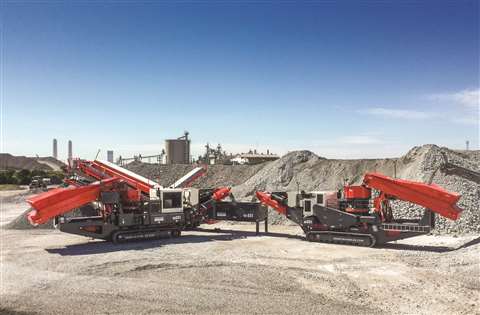
When recycling slag material, Tetsugen needs to produce a number of different and precise aggregate sizes. The end product is employed by construction and steel companies for the purposes of road construction and use in concrete foundations. To this end, the company presently utilizes a Sandvik QS331 gyratory cone crusher, a QH331 Hydrocone crusher and a QA441 Doublescreen. The large slag feed size of 400 mm is accommodated by one of their jaw crushers, which is then fed directly into the QS331. This features the Sandvik CS430 gyratory cone which is able to accept feed sizes up to 340 mm. The material is then processed by the QH331. The cone crushers feature Sandvik’s Hydrocone technology.
The QA441 Doublescreen provides the sized aggregates required. The 0-40 mm and 0-25 mm are used in road construction, the 5-20 mm aggregates in concrete foundations.
Sandvik’s Doublescreen technology has two independently adjustable screenboxes which aid precision while screening, resulting in high-quality products for Tetsugen’s customers. The Doublescreen’s independently adjustable screenboxes deliver exceedingly high precision screening.
Sandvik says that, when performing together in normal conditions, the trio of machines provides an output of approximately 250 metric tph.
Custom-built
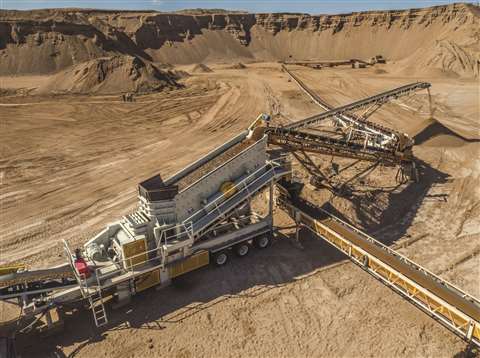
The portable F-Class vibrating screen from Haver & Boecker features a hydraulic system for optimum screen angle
Haver & Boecker’s new portable F-Class vibrating screen offers mobility and flexibility, with a base frame that attaches to a custom-built chassis.
It features a hydraulic system that ensures the vibrating screen is positioned at the optimal angle.
The screen, which the firm says can be setup in less than 30 minutes, is designed with a double eccentric shaft, supported by four double-spherical roller bearings.
Haver & Boecker Canada president, Karen Thompson, says, “Our leading edge, four-bearing screening technology virtually eliminates the common issues of pegging, blinding and cross contamination, therefore increasing overall efficiency and profitability.”
The F-Class also features Haver & Boecker’s Ty-Rail quick-tensioning system, which promises a reduction of up to 50% in machine downtime for screen media change-outs.
Another benefit with the F-Class is that it comes with a 36-month full-service warranty – including parts inspection, equipment assessment ad screen media evaluation.
Last year also saw Haver & Boecker introduce its Tyler brand of hooked engineered screen media as a solution to the problem of expensive deck conversions. The company says its tensioned screen media can be used on a cambered deck, eliminating the need for a deck conversion when switching from woven wire to polyurethane screen media.
Hydraulics
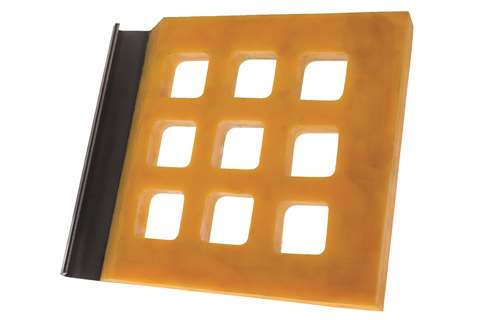
Ty-Max is one example of Haver & Boecker’s new Tyler brand of hooked engineered screen media
Ease of use and dependability are at the fore with Ohio-based IRock’s TS-512 tracked screening plant, aimed at small to medium-sized producers.
Along with the promise of speedy set up and tear down, many components of the screener, such as the conveyors, are hydraulically powered so operators can easily move them into place for production or fold them down for transportation. The TS-512 also offers intuitive, easy-to-use controls.
The machine will sort materials such as aggregates, coal, concrete, gravel, limestone, sand and topsoil, and promises easy setup and onsite mobility.
With two high-energy, two-bearing decks, the TS-512 offers a total screening area of 10.4 m2, and the interchangeable screen media gives producers a range of options over the size of the end product.
With a hopper volume of almost 9.2 cubic metres and a CAT Tier 3 engine, the screener can process up to 400 tph of material. And at 5 m high, operators can put a large amount of material beneath the belt before having to move the machine to the next stockpile.
It’s all in the bucket
In 2016, Atlas Copco added two new bucket crushers to its range – BC2100 and BC5300. The new crushers brings the Atlas Copco range up to service weights of 2,000 to 5,300 kg, suitable for carriers weighing from 18 to 54 tonnes.
Atlas Copco says the new crushers have increased durability and reliability, and offer up to 30% higher output with the new circular crushing cycle, together with a significant reduction in maintenance.
A twin-drive system comprises two hydraulic motors. The timing belt is designed for long service life and the system promises increased torque from the start.
Two useful features on the new BC bucket crusher provide stable productivity. The automatic anti-lock mechanism gives continuous repositioning of the material, ensuring that even larger pieces are guided automatically in the direction of the crushing jaw.
If the material gets jammed, the reversing function enables the operator to change the rotation direction, push the material back into the inlet and thus easily remove the blockage.
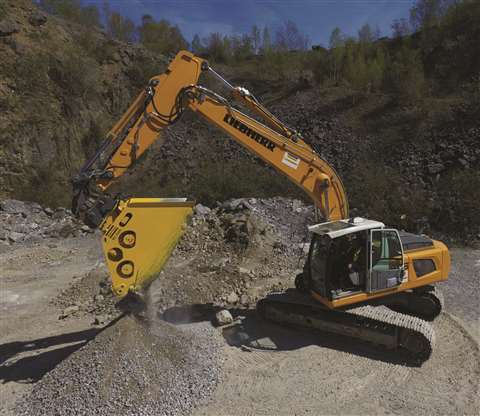
Atlas Copco says the unique circular crushing cycle on its new bucket crushers can increase output by up to 30%
Designed predominantly for demolition, recycling and road construction applications, the firm says its bucket crushers are a viable alternative to jaw crushers.
Price of Liberty
The US-based material processing and handling systems manufacturer, Superior, recently acquired Canada-based Clemro Western.
In doing so, it also acquired the original design for the Liberty Jaw Crusher, which its own engineers refined, after collecting feedback from customers.
The result was the unveiling of the new crusher in December last year.
A primary crusher, the unit compresses stone, concrete and asphalt with an aggressive nip angle, allowing the machine to consistently and efficiently grab and process material.
With feed openings that range from 457 mm by 914 mm to 914 mm by 1219 mm, the jaw dies also have integrated lifting points, offering safe replacement and installation.
The unit’s frame-mounted motor give it a smaller footprint, freeing up deck space for maintenance – and maintenance time is reduced with the addition of hydraulic tensioning system and hydraulic wedge adjustment.
Small is beautiful too
While there has always been a strong case for large bucket crushers, BAV Crushers is now championing its attachments for smaller machines.
BAV says its bucket crushers come into their own on sites which generate small volumes of rubble and where there are restrictions on transport, access and space.
The company says, “Very often, contractors are generating volumes of rubble which are simply uneconomic to transport off site, even where logistics might allow access for tippers of skip trucks. There may be no space to store waste on site, but if it can be crushed, there is a use for it right away. Where there is either congestion or a long distance to be travelled for waste taken off site, the numbers stack up even more in favour of on-site recycling.”
The range from BAV Crushers includes those for use with large excavators, but the firm also has attachments for machines from just 2.5 tonnes.






